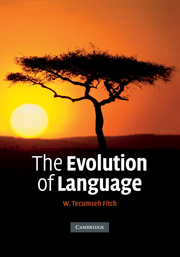Book contents
- Frontmatter
- Contents
- List of figures
- Acknowledgments
- Introduction
- SECTION 1 THE LAY OF THE LAND
- SECTION 2 MEET THE ANCESTORS
- 5 Meet the ancestors
- 6 The LCA: our last common ancestor with chimpanzees
- 7 Hominid paleontology and archaeology
- SECTION 3 THE EVOLUTION OF SPEECH
- SECTION 4 EVALUATING PHYLOGENETIC MODELS OF LANGUAGE EVOLUTION
- Glossary
- Appendix: species names
- References
- Author index
- Subject index
- Species index
7 - Hominid paleontology and archaeology
Published online by Cambridge University Press: 05 June 2012
- Frontmatter
- Contents
- List of figures
- Acknowledgments
- Introduction
- SECTION 1 THE LAY OF THE LAND
- SECTION 2 MEET THE ANCESTORS
- 5 Meet the ancestors
- 6 The LCA: our last common ancestor with chimpanzees
- 7 Hominid paleontology and archaeology
- SECTION 3 THE EVOLUTION OF SPEECH
- SECTION 4 EVALUATING PHYLOGENETIC MODELS OF LANGUAGE EVOLUTION
- Glossary
- Appendix: species names
- References
- Author index
- Subject index
- Species index
Summary
What the fossils tell us
In broad outline, the post-LCA history of our species is becoming increasingly clear from a combination of fossil, archaeological, and genetic data. All hominid populations originated in Africa, but several waves of early hominids expanded into Europe and Asia. The last wave of migrants was our own species, Homo sapiens (“anatomically modern Homo sapiens,” or AMHS), who left Africa in one or more migrations by 50 kya (thousand years ago). These humans were accompanied by a wide range of technological and artistic innovations relative to all earlier hominids. They were capable of making difficult sea crossings to destinations beyond the horizon, and expanding along a “coastal express” route fringing the Indian Ocean, and had made it to the Andaman islands and Australia by around 45 kya (Lahr and Foley, 1998; Mellars, 2006). AMHS witnessed (or caused) the complete extinction of all previously existing hominid lines, including Homo erectus in Asia and Homo neanderthalensis in Europe. Because all existing human populations have full and equal language abilities, this at least fifty thousand year divergence time marks the latest possible end to our species' evolutionary journey to language.
Although human paleontology is a highly controversial discipline, some crucial fossil finds since the 1960s allow us to make certain empirical statements with confidence. Our fossil record for hominids becomes rich around four million years ago, roughly two-thirds of our post-LCA evolution.
- Type
- Chapter
- Information
- The Evolution of Language , pp. 250 - 294Publisher: Cambridge University PressPrint publication year: 2010



